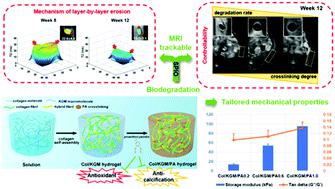当前位置:
X-MOL 学术
›
J. Mater. Chem. B
›
论文详情
Our official English website, www.x-mol.net, welcomes your
feedback! (Note: you will need to create a separate account there.)
Proanthocyanidin-crosslinked collagen/konjac glucomannan hydrogel with improved mechanical properties and MRI trackable biodegradation for potential tissue engineering scaffolds.
Journal of Materials Chemistry B ( IF 6.1 ) Pub Date : 2019-11-26 , DOI: 10.1039/c9tb02053e Jinlin Chen 1 , Zhongyuan Cai 1 , Qingrong Wei 1 , Dan Wang 2 , Jun Wu 3 , Yanfei Tan 1 , Jian Lu 1 , Hua Ai 1
Journal of Materials Chemistry B ( IF 6.1 ) Pub Date : 2019-11-26 , DOI: 10.1039/c9tb02053e Jinlin Chen 1 , Zhongyuan Cai 1 , Qingrong Wei 1 , Dan Wang 2 , Jun Wu 3 , Yanfei Tan 1 , Jian Lu 1 , Hua Ai 1
Affiliation

|
Collagen (Col) has been intensively exploited as a biomaterial for its excellent biocompatibility, biodegradation and bioactivity. However, the poor mechanical properties and rapid biodegradation of reconstituted collagen hydrogels have always been the bottlenecks for their further development especially for vascular tissue engineering. Herein, based on the self-assembly characteristics of collagen, a ternary hydrogel scaffold, comprising rigid collagen molecules, flexible konjac glucomannan (KGM) chains and biocompatible crosslinkers of proanthocyanidin (PA), has been designed to achieve a synergistic interaction for essentially optimizing the mechanical properties of the so-obtained Col/KGM/PA hydrogel, which possesses not only substantially improved strength but also good elasticity. PA endows these scaffolds with controllable biodegradation and anti-calcification and antioxidant activities. TEM discovered the co-existence of two types of fibrils with distinctly different arrangement patterns, explaining the contribution of KGM macromolecules to elasticity generation. The in vivo variations of Col/KGM/PA implants are visualized in real-time by magnetic resonance imaging (MRI). Moreover, a quantitative technique of MRI T2-mapping combined with histology is designed to visualize the in vivo biodegradation mechanism of layer-by-layer erosion for these hydrogels. Simultaneously, three different relationships between the respective processes of in vivo degradation and in vivo dehydration of these controlled hydrogel implants were clearly revealed by this technique. Such a designed Col/KGM/PA composite hydrogel realizes the essential integration of good biocompatibility, controllable biodegradation and improved mechanical properties for developing a desired scaffold material for tissue engineering applications.
中文翻译:

原花青素交联的胶原蛋白/ konjac葡甘露聚糖水凝胶具有改善的机械性能和MRI可追踪的生物降解能力,可用于潜在的组织工程支架。
胶原蛋白(Col)因其出色的生物相容性,生物降解性和生物活性而被广泛地用作生物材料。然而,重建的胶原蛋白水凝胶的差的机械性能和快速的生物降解一直是它们进一步发展的瓶颈,特别是对于血管组织工程而言。本文中,基于胶原蛋白的自组装特性,已设计了包含刚性胶原蛋白分子,柔性魔芋葡甘露聚糖(KGM)链和原花青素(PA)的生物相容性交联剂的三元水凝胶支架,以实现协同相互作用,从而从本质上优化了所获得的Col / KGM / PA水凝胶的机械性能不仅具有显着提高的强度,而且具有良好的弹性。PA使这些支架具有可控的生物降解,抗钙化和抗氧化活性。TEM发现两种类型的原纤维共存,排列模式明显不同,这解释了KGM高分子对弹性生成的贡献。这Col / KGM / PA植入物的体内变异通过磁共振成像(MRI)实时可视化。此外,设计了一种结合组织学的MRI T 2映射定量技术,以可视化这些水凝胶的逐层腐蚀的体内生物降解机制。同时,体内降解和体内各自过程之间的三种不同关系这些受控的水凝胶植入物的脱水明显地通过这种技术得以揭示。这样设计的Col / KGM / PA复合水凝胶实现了良好的生物相容性,可控的生物降解和改善的机械性能的基本集成,从而为组织工程应用开发了所需的支架材料。
更新日期:2019-11-26
中文翻译:

原花青素交联的胶原蛋白/ konjac葡甘露聚糖水凝胶具有改善的机械性能和MRI可追踪的生物降解能力,可用于潜在的组织工程支架。
胶原蛋白(Col)因其出色的生物相容性,生物降解性和生物活性而被广泛地用作生物材料。然而,重建的胶原蛋白水凝胶的差的机械性能和快速的生物降解一直是它们进一步发展的瓶颈,特别是对于血管组织工程而言。本文中,基于胶原蛋白的自组装特性,已设计了包含刚性胶原蛋白分子,柔性魔芋葡甘露聚糖(KGM)链和原花青素(PA)的生物相容性交联剂的三元水凝胶支架,以实现协同相互作用,从而从本质上优化了所获得的Col / KGM / PA水凝胶的机械性能不仅具有显着提高的强度,而且具有良好的弹性。PA使这些支架具有可控的生物降解,抗钙化和抗氧化活性。TEM发现两种类型的原纤维共存,排列模式明显不同,这解释了KGM高分子对弹性生成的贡献。这Col / KGM / PA植入物的体内变异通过磁共振成像(MRI)实时可视化。此外,设计了一种结合组织学的MRI T 2映射定量技术,以可视化这些水凝胶的逐层腐蚀的体内生物降解机制。同时,体内降解和体内各自过程之间的三种不同关系这些受控的水凝胶植入物的脱水明显地通过这种技术得以揭示。这样设计的Col / KGM / PA复合水凝胶实现了良好的生物相容性,可控的生物降解和改善的机械性能的基本集成,从而为组织工程应用开发了所需的支架材料。











































 京公网安备 11010802027423号
京公网安备 11010802027423号